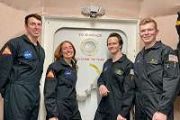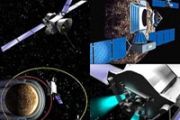Displaying items by tag: DSAC
Deep Space Atomic Clock (DSAC)
The Deep Space Atomic Clock project (DSAC), will fly and validate a miniaturized, ultra-precise mercury-ion atomic clock that is orders of magnitude more stable than today's best navigation clocks.
DSAC: Key Mission Facts
- The Deep Space Atomic Clock will be orders of magnitude more stable than any other atomic clock flown in space, as well as smaller and lighter.
- This NASA Technology Demonstration Mission will shift paradigms for navigating spacecraft to distant destinations, enabling collection of more data with better precision; and enabling autonomous radio navigation for time-critical events such as orbit insertion or landing.
- This mission will deliver the next generation of deep-space radio science.
Precise radio navigation -- using radio frequencies to determine position -- is vital to the success of a range of deep-space exploration missions. Ground-based atomic clocks have long been the cornerstone of most deep-space vehicle navigation because they provide root data necessary for precise positioning. The Deep Space Atomic Clock will deliver the same stability and accuracy for spacecraft exploring the solar system. This new capability could forever change the way we conduct deep-space navigation -- by eliminating the need to "turn signals around" for tracking. Much the same way modern Global Positioning Systems, or GPS, use one-way signals to enable terrestrial navigation services, the Deep Space Atomic Clock will provide the same capability in deep-space navigation -- with such extreme accuracy that researchers will be required to carefully account for the effects of relativity, or the relative motion of an observer and observed objected, as impacted by gravity, space and time (clocks in GPS-based satellite, for example, must be corrected to account for this effect, or their navigational fixes begin to drift).
Over the past 20 years, engineers at NASA's Jet Propulsion Laboratory in Pasadena, Calif., have been steadily improving and miniaturizing the mercury-ion trap atomic clock, preparing it to operate in the harsh environment of deep space. In the laboratory setting, the Deep Space Atomic Clock's precision has been refined to permit drift of no more than 1 nanosecond in 10 days.
Now (Dec. 2013) the DSAC team is preparing a miniaturized, low-mass atomic clock -- orders of magnitude more accurate and stable than any other atomic clock flown in space, while still being smaller and lighter -- for a test flight in low-Earth orbit. The clock will make use of GPS signals to demonstrate precision orbit determination and confirm its performance, promising new savings on mission operations costs, delivering more science data and enabling further development of deep-space autonomous radio navigation.
The DSAC project currently is building a demonstration unit and payload to be hosted on a spacecraft provided by Surrey Satellite Technologies U.S. of Englewood, Colo. It will launch to Earth orbit in 2015, where the payload will be operated for at least a year to demonstrate its functionality and utility for one-way-based navigation.




































